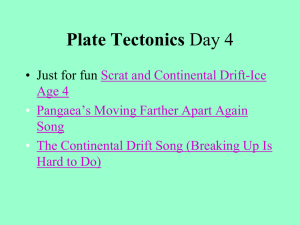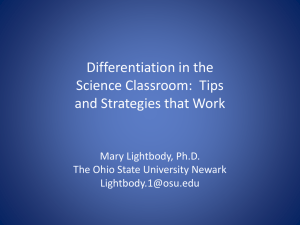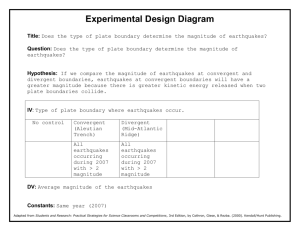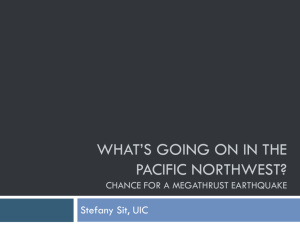Daniel_Hardwick_pres..
advertisement
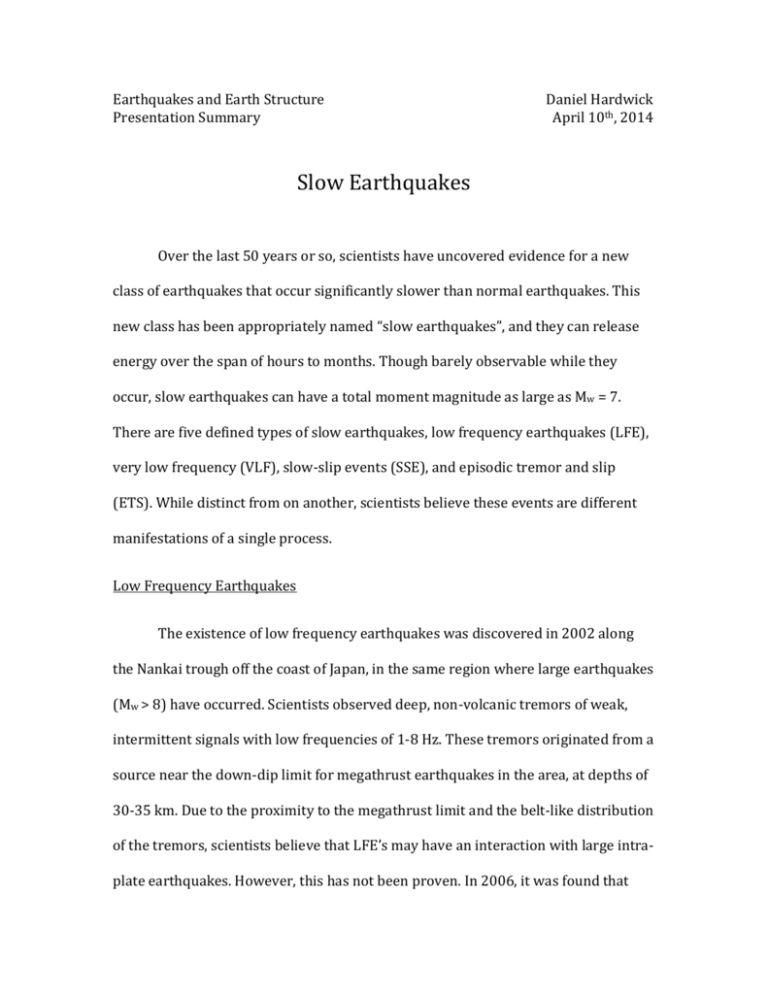
Earthquakes and Earth Structure Presentation Summary Daniel Hardwick April 10th, 2014 Slow Earthquakes Over the last 50 years or so, scientists have uncovered evidence for a new class of earthquakes that occur significantly slower than normal earthquakes. This new class has been appropriately named “slow earthquakes”, and they can release energy over the span of hours to months. Though barely observable while they occur, slow earthquakes can have a total moment magnitude as large as Mw = 7. There are five defined types of slow earthquakes, low frequency earthquakes (LFE), very low frequency (VLF), slow-slip events (SSE), and episodic tremor and slip (ETS). While distinct from on another, scientists believe these events are different manifestations of a single process. Low Frequency Earthquakes The existence of low frequency earthquakes was discovered in 2002 along the Nankai trough off the coast of Japan, in the same region where large earthquakes (Mw > 8) have occurred. Scientists observed deep, non-volcanic tremors of weak, intermittent signals with low frequencies of 1-8 Hz. These tremors originated from a source near the down-dip limit for megathrust earthquakes in the area, at depths of 30-35 km. Due to the proximity to the megathrust limit and the belt-like distribution of the tremors, scientists believe that LFE’s may have an interaction with large intraplate earthquakes. However, this has not been proven. In 2006, it was found that LFE’s in Japan occurred almost exclusively during non-volcanic tremor episodes, and originated along subduction zone plate boundaries as a result of shear-slip. From this correlation scientists interpreted that non-volcanic tremor is the result of a swarm of LFE’s. Very Low Frequency Earthquakes Very low frequency earthquakes were discovered in 2007, also off the coast of Japan. These events had a moment magnitude of M = 3-3.5, and had characteristic durations of ~20 seconds which are distinct from LFE’s. In 2008, larger VLF events were recorded which were of magnitude M = 4 and a longer duration of up to 200 seconds. There appear to be two categories of VLF’s. One type occurs at shallow depths offshore within accretionary prisms, while the other type occurs at the same time and location as tremor and large-scale slow earthquakes. The shallow VLF’s seem consistent with deformation of the accretionary prism, while the deep VLF’s are consistent with slip along plate boundaries. Although distinct from one another, VLF’s and LFE’s often occur together, as multiple LFE’s in close succession can cause VLF’s through aggregation of low frequency components. In this respect, LFE’s appear to be a necessary condition for the occurrence of VLF’s, although the opposite relationship if not true. Slow-Slip Events Slow-slip events were discovered in 1999 and are caused by slip along faults, the same mechanism that causes large earthquakes. However, as the name suggests, they occur very slowly and the waves they generate are unusually weak for a normal earthquake of the same magnitude. Slow-slip events have only been observed at subduction zones, such as Cascadia in North America, Japan, Guerrero Mexico, and North Island, New Zealand. Slow-slip events at all of these locations share the characteristic of occurring at or near the base of the seismic zone in which large, ordinary earthquakes take place. Due to their consistent hypocenters, scientists believe that SSE’s may represent part of the transition zone between completely locked and completely slipping segments of intra-plate boundaries in subduction zones. Cause of Deep Non-volcanic Tremor As the name suggests, deep non-volcanic tremor is different from volcanic tremor, which occurs in magmatic systems and is thought to occur from the movement of fluids through channels beneath volcanoes into the surrounding solid lithosphere. Non-volcanic tremor, which is a weak, persistent shaking of the earth, is thought to occur a result of fluid movement as well. Based on frequent observations in southwestern Japan along the subduction zone between the Philippine Sea plate and Amur plate, scientists believe that non-volcanic tremor is related to metamorphic dehydration reactions. This process releases water from the subducting plate into the surrounding lithosphere, resulting in fluid movement.






